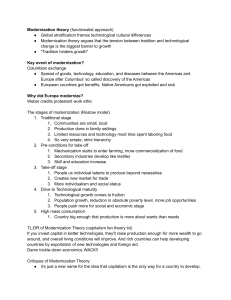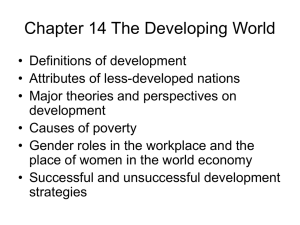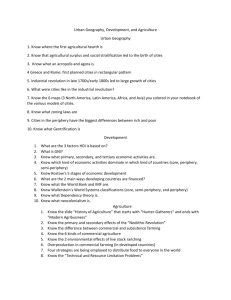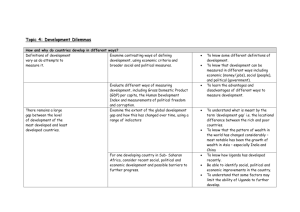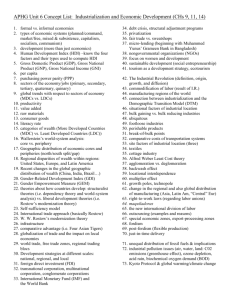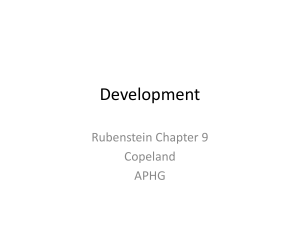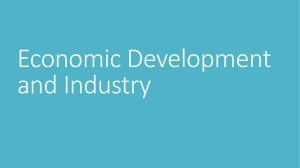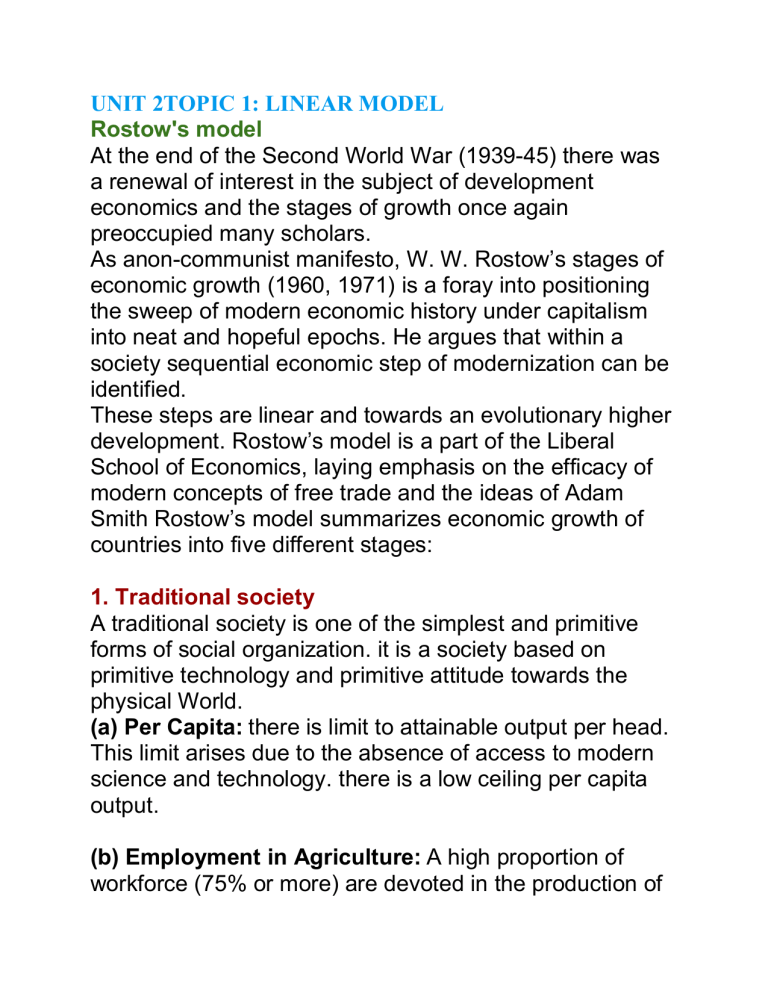
UNIT 2TOPIC 1: LINEAR MODEL Rostow's model At the end of the Second World War (1939-45) there was a renewal of interest in the subject of development economics and the stages of growth once again preoccupied many scholars. As anon-communist manifesto, W. W. Rostow’s stages of economic growth (1960, 1971) is a foray into positioning the sweep of modern economic history under capitalism into neat and hopeful epochs. He argues that within a society sequential economic step of modernization can be identified. These steps are linear and towards an evolutionary higher development. Rostow’s model is a part of the Liberal School of Economics, laying emphasis on the efficacy of modern concepts of free trade and the ideas of Adam Smith Rostow’s model summarizes economic growth of countries into five different stages: 1. Traditional society A traditional society is one of the simplest and primitive forms of social organization. it is a society based on primitive technology and primitive attitude towards the physical World. (a) Per Capita: there is limit to attainable output per head. This limit arises due to the absence of access to modern science and technology. there is a low ceiling per capita output. (b) Employment in Agriculture: A high proportion of workforce (75% or more) are devoted in the production of agricultural goods. High proportion of resources are also devoted in the agricultural section. (c) Social Mobility: A hierarchical, hereditary, statusoriented social structure in which there is little possibility for vertical mobility. d) Political Power: The center of gravity of political power was localistic, region-bound and primarily based on land ownership. The value system that prevails in such a society is what Rostow calls a long-run fatalism. People of these societies think that not much economic progress is possible for them and for their future generations. 2. Preconditions for take off ★The covers a long period of a century or more during which the preconditions for take-off are established. These conditions mainly comprise fundamental changes in the social, political and economic fields; for example, : (a) A change in society’s attitudes towards science, risktaking and profit-earning (b) The adaptability of the labor force (c) Political sovereignty (d) Development of a centralized tax system and financial institutions (e) The construction of certain economic and social infrastructure like railways, ports, power generation and educational institutions. India did some of these things in the First Five Year plan period (1951-56). ★It is evident from above that in this second stage of growth foundations for economic transformation are laid. The people start using modern science and technology for increasing productivity in both agriculture and industry and start producing not just for consumption but for sale. ★Further, there is a change in the attitude of the people who start viewing the world where there are possibilities of future growth. A new class of entrepreneurs emerges in the society homilies savings and undertake investment in new enterprises and bear risks and uncertainty. ★The main focus of this stage is to ensure that investment levels are above 5% of the national income depending on various sectors of the economy. ★The pre-conditions of take-off closely track the historic stages of the (initially) British Industrial Revolution. 3. Take Off ★The take-off stage marks the transition of the society from a backward one to one that is on the verge of freeing itself from the elements that retard growth. This is the crucial stage which covers a relatively brief period of two to three decades in which the economy transforms itself in such a way that economic growth subsequently takes place more or less automatically. ★Thus, the term “take-off” implies three things: 1)first the proportion of investment to national income must rise from 5% to 10%and more 2) secondly, the period must be relatively short so that it should show the characteristics of an economic revolution 3) thirdly, it must culminate in self-sustaining and self-generating economic growth. ★Thus, during the take-off stage, the desire to achieve economic growth to raise the living standards dominates the society. Revolutionary changes occur in both agriculture and industry and productivity levels sharply increase. ★There is greater urbanization and urban labor force increases. In a relatively short period of a decade or two, both the basic structure of the economy and social and political structure is changed So that a self-sustaining growth rate can be maintained. ★It is worth noting that in the opinion of Rostow, the rise of new elite (i.e., new entrepreneurial class) and establishment of a nation state are crucial for economic development. ★Development of One Leading Sector: Development of export industries has led to takeoff in some countries. Example grains in USA, Canada and Russia, Timber in Sweden. Sector or the sectors that led to take off were varied according to countries. However, Rostow has concluded that any industry can play the role of leading sector in the take offstage that to be met with 4. Drive to maturity This stage of economic growth occurs when the economy becomes mature and is capable of generating self- sustained growth. Generally, the Drive to Maturity starts about 60 years after “Take Off “The rates of saving and investment are of such a magnitude that economic development becomes automatic. Overall capital per head increases as the economy matures. The structure of the economy changes increasingly. (1) Emergence of New Industries: The initial key industries which sparked the take-off decelerate. The average rate of growth is maintained by a succession of new rapidlygrowing sectors with a new set of leading sectors. Industries like heavy engineering, iron and steel, chemicals, machine tools, agricultural implements, automobiles etc. take the driver’s seat. (2) Shift in the Occupational Distribution: Work force composition in agriculture shifts from 75% of the working population to 20%. The workers acquire greater skill and their wages increase in real terms. Example: As during Industrial Revolution many industries established in Britain and the countries of. Western Europe, the work force was shifted from agricultural sector to the manufacturing sector. The proportion of the working force engaged in the agricultural sector went down to 20% or less. (3) More skilled workers (4) The character of leadership changes significantly in the industries and a high degree of professionalism is introduced (5) Environmental and health cost of industrialization is recognized and policy changes are Thomasena prime example of a country in the Drive to Maturity stage is South Africa. It is developing a world-class infrastructureincluding a modern transport network, widely available energy, and sophisticated telecommunications facilities. Additionally, the commercial farm sector shed140,000 jobs, a decline of roughly 20%, in the eleven-year period from 1988 to 1998. 5. Age of high mass consumption ●In this stage of development per capita income of country rises to such a high level that consumption basket of the people increases beyond food, clothing and shelters to articles of comforts and luxuries on a mass scale. Further, with progressive industrialization antiurbanization of the economy values of people change in favor of more consumption of luxuries and high styles of living. ●New types of industries producing durable consumer goods come into existence which satisfies the wants for more consumption. These new industries producing durable consumer goods become the new leading sectors of economic growth. ●increase in employment in the service sectors and high incomes ● In this age of high mass consumption, the society is able to choose between concentrating on military and security issues, on equality and welfare issues or developing luxuries for its upper-class. Historically, the United States is said to have reached this stage first, followed by other western European nations, and then Japan in the 1950s. Criticism of the model 1. Rostow is historical in the sense that the end result is known at the outset and is derived from the historical geography of a developed, bureaucratic society.2. Rostow is mechanical in the sense that the underlying motor of change is not disclosed and therefore the stages become little more than a classificatory system based on data from developed countries.3. His model is based on American and European history and defines the American norm of high mass consumption as integral to the economic development process of all industrializedsocieties.4. His model assumes the inevitable adoption of Neoliberal trade policies which allow the manufacturing base of a given advanced polity to be relocated to lower-wage regions.5. Rostow's model does not apply to the Asian and the African countries as events in these countries are not justified in any stage of his model. The stages are not identifiable properly as the conditions of the take-off and pre-take-off stage are very similar and also overlap.6. According to Rostow growth becomes automatic by the time it reaches the maturity stage but Kuznets asserts that no growth can be automatic there is need for push always. TOPIC 2: Non-Linear: World System Theory, Neo-Marxist Theory WORLD SYSTEMS THEORY Modernization theory claimed that once developing societies came into contact with western European and North American societies, they would be impelled toward modernization and, eventually, would achieve the economic, political, and social features characteristic of the nations of western Europe and the United States. However, by the 1960s it was apparent that the Third World was not passing through a stage of underdevelopment, as envisioned by modernization theory, but remaining underdeveloped. Thus, a counterclaim was advanced—that developing countries today are structurally different from the advanced countries and so will have to develop along different lines. This perspective formed the basis of what came to be known as dependency theory. Dependency theory rejects the limited national focus of modernization theory and emphasizes the importance of understanding the complexity of imperialism and its role in shaping postcolonial states. World systems theory is a response to the criticisms of Dependency Theory. World Systems Theory was developed by Immanuel Wallerstein (1979). Wallerstein accepts the fact ex-colonies are not doomed to be forever trapped in a state of dependency; it is possible for them to climb the economic ladder of development, as many of them have done. However, he also believes that the global capitalism system still requires some countries, or at least regions within countries to be poor so they can be exploited by the wealthy at the top. One must look at the world system as a whole, rather than just at individual countries. Dependency Theory tended to argue that countries are poor because they used to be exploited by other countries. However, focusing on countries (or governments/ nation states) is the wrong level of analysis – government today have declined in power, whereas Corporations are more powerful than ever. Global Corporations, and global capital, transcend national boundaries, and nation states (even wealthy ones) are relatively powerless to control them, thus in order to understand why countries are rich or poor, we should be looking at global economic institutions and corporations rather than countries. Global Economic Institutions form what Wallerstein calls a Modern World System, and all countries, rich and poor alike are caught up in it. According to the world’s system theory, the entire world at least since the 16th century, not merely a collection of independent countries but as a single capitalist world economy based on an international division of labor among a core that developed originally in northwestern Europe (England, France, Holland), a periphery, and a semi periphery consisting of core regions in decline (e.g., Portugal and Spain) or peripheries attempting to improve their relative position in the world economy (e.g., Italy, southern Germany, and southern France).The division of labor among these regions determined their relationship to each other as well as their type of labor conditions and political system. According to the world systems theory, the world is divided into three types of countries or areas: core, periphery, and semi-periphery. Core Countries Core countries are dominant capitalist countries that exploit peripheral countries for labor and raw materials. They are strong in military power and not dependent on any one state or country. They serve the interests of the economically powerful. They are focused on higher skill and capital-intensive production. Core countries are powerful, and this power allows them to pay lower prices for raw goods and exploit cheap labor, which constantly reinforces the unequal status between core and peripheral countries. The first core region was located in northwestern Europe and made up of England, France, and Holland. Today, the United States is an example of a core country. The U.S. has large amounts of capital, and its labor forces are relatively well paid. Periphery Countries Periphery countries fall on the other end of the economic scale. These countries lack a strong central government and may be controlled by other states. These countries export raw materials to the core countries, and they are dependent on core countries for capital and have underdeveloped industry. These countries also have lowskill, labor-intensive production, or, another words, cheap labor. Periphery countries are commonly also referred to as third-world countries. Eastern Europe and Latin America were the first peripheral zones. An example from today is Cape Verde, a chain of islands off the west coast of Africa. Foreign investors promote the extraction of raw materials and the production of cash crops, which are all exported to core countries. Semi-Periphery Countries Semi-periphery countries fall in the middle of the economic spectrum. These countries share characteristics of both core and periphery countries. These are core regions in decline or periphery regions attempting to improve their economic position. These countries are sometimes exploited by core countries, but they also may exploit periphery countries themselves. For example, India is largely dependent on core countries for capital, but India has a growing technology industry and an emerging consumer market. Dependency and world systems theories share a common emphasis on global analysis and similar assumptions about the nature of the international system and its impact on national development in different parts of the world, but they tend to emphasize different political dynamics. Dependency theorists tend to focus on the power of transnational classes and class structures in sustaining the global economy, whereas world systems analysts tended to focus on the role of powerful states and the interstate system TOPIC 3: Changing Paradigms of Development An important change that happens when the usual way of thinking or doing something is replaced by a new and different way. This discovery will bring about a paradigm shift in our understanding. Paradigm: the way you see something, your point of view, frame of reference or belief. The western model for development predominated in 1950s and 1960s. The modernization paradigm arose soon after World War II, in 1949. It envisioned development as a challenge to bring the "underdeveloped countries" out of their conditions of poverty by modernizing them and by free-market approaches. In this context, the modernization paradigm promoted by political scientists and scholars of Western countries became so strong and so pervasive in every dimension of social life that it became also known as the "dominant paradigm. “Modernization theory claimed that once developing societies came into contact with western European and North American societies, they would be impelled toward modernization and, eventually, would achieve the economic, political, and social features characteristic of the nations of western Europe and the United States. However, by the 1960s it was apparent that the Third World was not passing through a stage of underdevelopment, as envisioned by modernization theory, but remaining underdeveloped. Thus, a counterclaim was advanced—that developing countries today are structurally different from the advanced countries and so will have to develop along different lines. Modernization paradigm failed to materialize, approach focusing on people’s participation began to emerge. This participatory model is less oriented to the politicaleconomic dimension and more rooted in the cultural realities of development. The development focus has shifted from economic growth to include other social dimensions needed to ensure meaningful results in the long run The alternative paradigm emphasizes not only material development but also the development of values and cultures, grassroots participation reinforces the chances that communities will adopt activities appropriate for them. TOPIC 4: Alternative Paradigms: Participatory, Think local/Act global -Think global/Act local This approach adopted in the 1990s by the United Nations and other development organizations as key challenges to be addressed successfully. It is often presented as an alternative to mainstream “top-down” development. Participatory approach is a strategy that incorporates themes or content area that are of interest to the stakeholders. • The Participatory Approach is used as a tool to provide solutions to social problems that impact concerned in their daily life’s development programs had failed to motivate people. •Since, they were interested in persuading them about the benefits of adopting certain innovations. Development programs tried to bring foreign concepts, to feed information, to force local populations to accept Western ideas and practices without considering whether these practices fit existing cultures. This suggested a human-centered approach that valued the importance of interpersonal channels of communication in decision-making processes at the community level. •PARTICIPATORY COMMUNICATION approach capable of facilitating people's involvement indecision making about issues impacting their lives. The basic Common features of this perspective are the emphasis on people, the endogenous vision of development, and the attention to power and rights issues. Participatory approaches require a shift in the way individuals are considered, from passive recipients to active agents of development efforts. idea of such programs was an authoritarian concept. In addition to poverty reduction, they include objectives in education, gender equality, and health issues. Most development priorities are outlined within political frameworks based on the adherence to good governance and democratic principles (for example, freedom and human rights. The participation is not an absolute concept, and that it can be applied in different degrees, is part of the problem. A typology that includes seven different types of participation as interpreted and applied by various development organizations, The full categorization, the least participatory,1) passive participation,2) participation in information giving,3) participation by consultation,4) participation for material incentives, 5)functional participation,6)interactive participation, and7 ) s e l f - m o b i l i z a t i o n . (1) passive participation, when stakeholders attend meetings to be informed;(2) participation by consultation, when stakeholders are consulted but the decision making rests in the hands of the experts;(3) functional participation, when stakeholders are allowed to have some input, although not necessarily from the beginning of the process and not in equal partnership; and(4) empowered participation, when relevant stakeholders take part throughout the whole cycle of the development initiative and have an equal influence on the decision-making process. Information sharing and consultation are considered low-level forms of participation, while the other two are considered high-level forms. These types are consistent with others, such as declassification particular, participatory research methods allowed a growing role for local stakeholders and indigenous knowledge in the problem-analysis and problem-solving processes of development initiatives. The process of raising questions and engaging in dialogue stimulates(inspires) “critical consciousness,” which enables the shift to action (Freire, 1970). This is a bottom-up approach, that involves extensive discussions, conversations, and decisionmaking with the target community. This process is facilitated with information and communication technology (ICT) with the goal of strengthening individual & social development• This participatory content creation is an important tool for resolving problems and creating a digitally advanced knowledge society • Public should be involved fully in the policy process in that authorities seek public views and participation, instead of treating the public as simply passive recipients of policy decisions. Research conducted by several debt. agencies (World Bank, CIDA (Community & Individual Development Association), USAID (US Agency for International development.), IRDP-Institute of Rural development Planning) suggests that there are many benefits of PD. • Studies suggest --PD projects may have high startup costs, but they will be less expensive & more sustainable in the long run • PD projects are effective at addressing local needs & generally more relevant to local populations than traditional development projects

